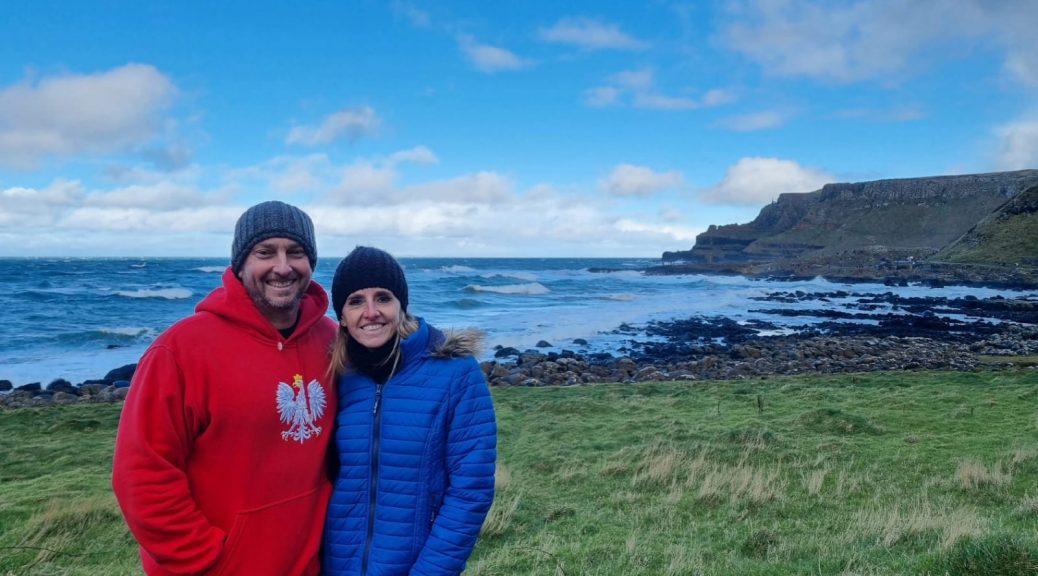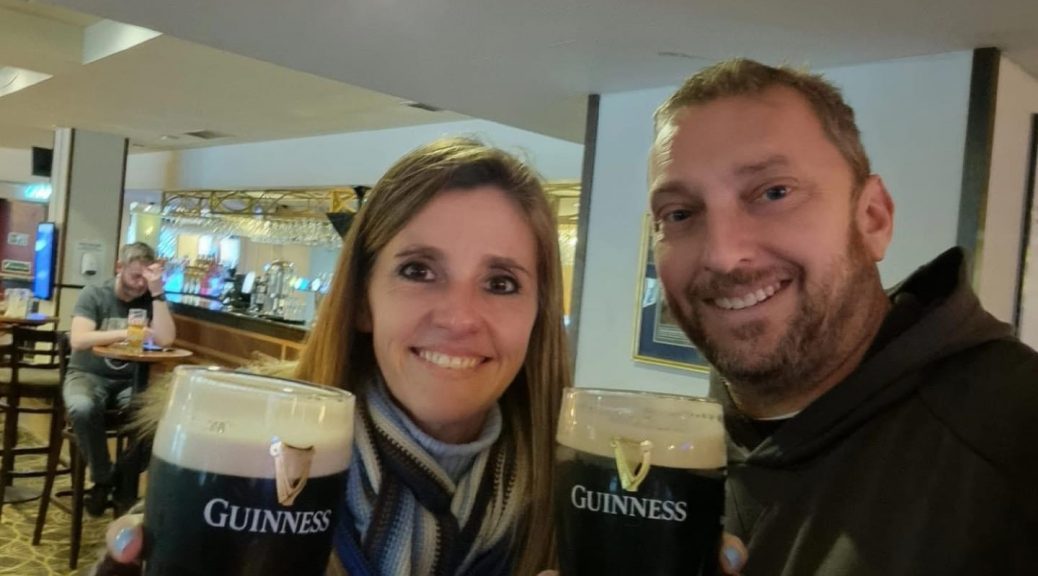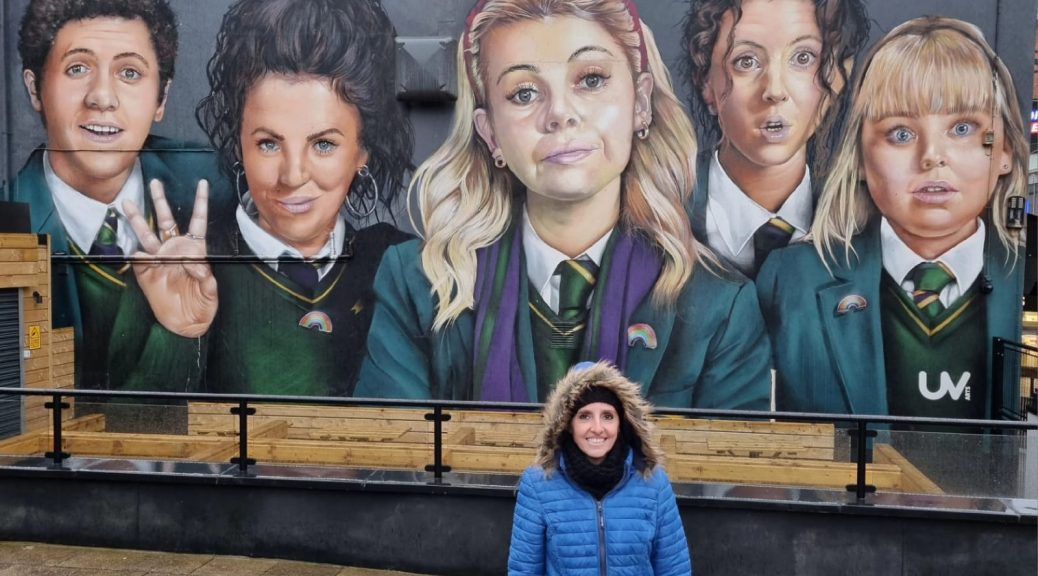GIANT’S CAUSEWAY
13-15 March 2023
We arrived at the airport in Castletown, Isle of Man, with plenty of time to spare.
For a small airport, there were five gates servicing an impressive variety of destinations. Sadly, our flight to Belfast was delayed, so we hunkered down in the waiting room with a surprising number of other people also waiting, also with delays.
Our flight was a mere hop (about 100km according to Chris) and we had barely completed ascension when we began our descent into Belfast.
We collected our rental car, a spanky new Ford Focus (quite a step-up on our usual entry-level rentals – and twice the car for half the price compared to Isle of Man!) and headed to our first destination, Castle Carrickfergus. We hoped the detour would not be in vain since we were quite far behind schedule.
Driving into the dusk, the Irish countryside was a sight to behold. Puffy white clouds on the horizon with endless green fields rolling to meet them.
On arrival in Carrickfergus, we drove right up to the Castle and were able to take some very nice snaps from a few key aspects. Worth noting that it didn’t look like we would have been able to go inside even if we had arrived earlier.
On to our home for the night, Larne, which the Vikings had used as a safe harbour for their long boats as they returned home from raiding the rich monasteries up the Irish coast. They named it “Ulfreksfjord”, which is the origin of the town’s other name, “Olderfleet”, and we’re finally defeated In 1018 by a llocal King, Connor.
We had booked at the Harbour Inn, thinking that being a seaside town it would be where the action was. It was right on the harbour, but more of a working port than the waterfront we had imagined.
Nevermind, the only agenda for the evening was a fish ‘n chips dinner, and our hostess proactively recommended we visit the Olderfleet restaurant around the corner, known for their great seafood.
Happy to oblige the recommendation, we were soon seated at a cosy table right next to the fireplace to dry off and warm up from the short but wet walk between the B&B and the restaurant.
Our waitress told us that their establishment – a local legend apparently – was famed for its Chowder, so we compromised and ordered a large bowl of the creamy seafood goodness to share alongside a crunchy battered Cod on a bed of hand cut chips. Perfect fill for a chilly night!
TUESDAY
With a vigourous day ahead of us, we decided to have a rest day on the running front. We awoke to an abnormally clear, blue-skies sunshiny day.
We filled our tanks with a sumptuous Full Irish breakfast (that included both potato bread and soda bread) and set out to do the walk along the promenade that our hostess had recommended.
The weather gods rewarded our good decision, and the Sun kept us company on our walk. Not that it provided any warmth, but it was a novelty for our commemorative pics as we did a quick lap of the promenade and got snaps of the memorials that were the noted landmarks along the waterfront.
Then it was off to Giant’s Causeway.
Timed just about perfectly, the sun disappeared as we were driving out of town. It started sleeting and minutes later the temperature had plummeted to zero degrees! Not so bad in our comfy car with the heater belting.
We stopped as planned in Ballycastle. We had not banked on more snow, so it was slow-going as we trudged up the hill on the signposted Historic Walking Trail. We did not get as far as the castle before deciding to turn back to resume our road trip.
True to form, by the time we were back at the car the snow had stopped and the Sun had come out. We satisfied ourselves with a photograph of the memorial in the Town Square to commemorate the moment with a shrug and a laugh, and got back in the car.
We then made our way to The Dark Hedges, a notorious and eerie film set from the TV series Games of Thrones. We realised we must be in quite a temperamental micro-climate, as we got out of the car in sunshine, walked a few hundred metres to the start of the hedges where it was snowing, got caught in a splash of rain as we trudged along the eerie avenue, to wash-rinse-repeat on the reverse journey. One can only put one’s hood up and roll with the punches.
On to Giant’s Causeway!
60 million years in the making, the Causeway was formed when Europe was starting to rip away from North America, in doing so creating huge rifts in the earth’s surface. These produced cracks and later erosion caused rivers to form, resulting in the distinctive hexagonal basalt stones.
If you believe in Science, that is.
Legend has it that an Irish giant named Finn McCool created the Causeway to get across the Irish Sea to face his rival, the Scottish giant Benandonner. Following their fearsome meeting, Benandonner ripped up the causeway as he fled back to Scotland, leaving behind the trail of hexagonal stones.
We kitted up and followed a group of people who looked like they knew where they were going. They had joined the Blue Trail, which led down to the water’s edge and the photo-friendly peninsula of hexagonal stones with backdrop of raging seas on 3 sides.
There were a lot of people posing for pictures and capturing the sight, but fortunately it was a GIANT’s causeway, so there was room for everyone to create spectacular photos that probably – like ours – looked like they were the only people there enjoying a desolate location.
Keen to see more of the coastline, we followed the Red route along the cliff face on the other side of the bay to get to the ‘Amphitheatre’. With the wind whipping around us, and the narrow and muddy trail, it was easy to understand when the trail came to an abrupt stop, with the thick wooden barriers citing caution of treacherous conditions including falling rocks.
Scaling back up to the top, we looked down on the trail and marvelled at the magnitude and magnificence of this natural wonder.
Looking behind us, the contrast of emerald green farmland and lazy sheep was just as breathtaking.
Our parking ticket had cost £10 on arrival but was redeemable at the Causeway Hotel for equivalent value. We traded our ticket for a pair of Rockshore pints and a caramel cheesecake, while our fingers and toes thawed out.
And then on to Bushmills, for our overnight stay.
Bushmills village dates from Norman times (1150–1520) and was originally known as Portcaman but as water powered industries developed from the 1600s, so did the village name. At one time there were seven mills working the river Bush and five distilleries.
With the discovery of the Giant’s Causeway by the wider world in the 1700s, Bushmills became the gateway for visitors, eager to see the mysterious grandeur. By the mid-1800 much of Bushmills had been re-developed and boasted at least three hotels, a busy livestock and produce market, a courthouse and a thriving distillery.
Today Bushmills is still regarded as the gateway to the Giant’s Causeway. With nearly 90 listed buildings, Bushmills is officially designated as a Conservation Village.
We had booked to stay at Finn McCool’s, a cosy B&B hosted above a local pub and easy walking distance to Old Bushmills Distillery.
Chris was so keen to get to the distillery, that we didn’t even unpack our bags, and shot straight up the road after parking the car at Finn’s.
Since Chris has already experienced the “how whiskey is made” tour before (and I’m not interested) we bypassed the usual organised events, and headed straight for the tasting room.
Chris ordered the single malt flight which comprised of three whiskeys, a 12-year-old reserve, a 16-year-old single malt and a 21-year-old single malt. Not a whiskey fan myself, I was delighted to be offered a whiskey-based cocktail called a Daisy that was mixed with all sorts of citrus and apple liqueurs, and barely tasted like whiskey at all!
Chris was enamoured with the 12-year-old reserve, and since it is only available for sale at the distillery, was compelled to order another to celebrate the experience. As an added bonus, when he ordered from the bar, the barman served the whiskey but said he was unable to charge for it since they had already cashed up.
Having immensely enjoyed our excursion, we supported the merchandise store by purchasing a T-shirt for Christian and a Hoodie for me. Another delightful bonus, Chris was told at checkout that his T-shirt was half price!
Chris was feeling quite heady as we retraced back to Finn McCool’s, checked in, and ordered a Pint of Guinness to settle into our new home. Interestingly, a pint of Guinness costs the same price as a pint of beer, which is quite unusual and quite a treat.
We enjoyed a lengthy chat with our host, who was generous with information about Bushmills, Northern Ireland, and the world in general, and was full of questions about our experience of life in South Africa. A regular glued to the bar weighed in periodically with an ‘aye’ or a ‘nay’ to nobody in particular.
By now it was nearly dinner time. Oddly, none of the pubs that we had been to in Northern Ireland so far served food. Our host did invite us to source takeaways from anywhere along the High Street and return to eat them in the pub.
Intent on taking him up on the offer, we exited onto the High Street to see what else was in town. We walked the length of the street and popped into Bushmills Inn to enjoy a beer in the glow of their fireplace.
With limited options on the short High Street, we decided to deviate from our traditional fish and chips to branch out to a Chinese meal (not something we do very often at home either), which we then took back to Finn’s and again enjoyed conversation with our host – with footie on the telly there was all-new conversation about the world of sports – and the regular who was still valiantly propping up the bar.
WEDNESDAY
We were up early enough to get in a quick run before the (inevitably giant) Full Irish breakfast that was included in our room rate. We ran through town, down to aptly-named Runkerry Beach, around the golf course and back along the High Street.
Only when we returned and were waiting at the bar counter for a warm-up tea and coffee did our hostess think to mention that we could actually have run along the tramlines all the way to Giant’s Causeway, only 2 miles away. That would have been epic!
While we were showering and packing, our hostess prepared a feast for us. And while we worked through the table full of goodness that she’d served, she gave a few hints and tips about sightseeing in the area.
It was obviously still cold but there was an icy wind taking real-feel temperature below what we were prepared to bear to visit the Rope Bridge at Carrick-a-Rede. Our hostess told us that with £10 parking fee and £13.50 each to access and cross the bridge, if we weren’t going to make a meal of it then it was best to overshoot the landmark and take the next (free) parking entrance, where there was a pathway to look-out points from where you could see the Rope Bridge.
Great compromise and we did exactly that as we drove out of town.
Last stop on the Giant’s Causeway coastal route was Dunluce Castle, ruins positioned dramatically on a sheer cliff face between Giant’s Causeway and Port Rush.
Even though we’d learnt to be more or less waterproof by now, the light drizzle was still a factor in the cost:benefit of £6 each to wander around the castle ruins. Figuring we would never beat the private tour of Rushen Castle a few days earlier (Castletown, Isle of Man) we satisfied ourselves with the pretty-legit observation decks.
The info on the display boards revealed that while the area had been inhabited for more than 1500 years, the Castle had been finished in 1608 by the MacDonnells, with an entire little town of Scottish-settler subsistence farmers feeding it.
The area was invaded in 1680 and the town burnt to the ground, with the remnants of the Castle bookmarking the story.


